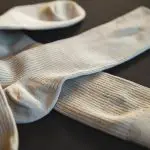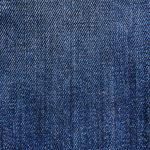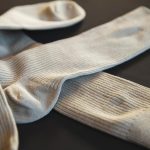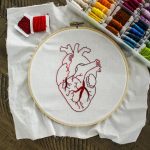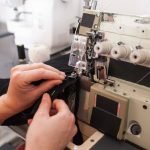Are you struggling to find the right needle for your satin fabric projects? Look no further! In this article, we will guide you through the different types of needles suitable for satin fabric, provide a helpful needle size guide, and offer tips on choosing the right needle point.
Whether you’re a beginner or an experienced sewer, we’ve got you covered. Say goodbye to thread snags and puckered seams – it’s time to master the art of satin sewing!
Table of Contents
Types of Needles for Satin Fabric
To prevent snags and damage to your satin fabric, you should use a fine needle with a sharp point. Satin fabric is delicate and prone to snags and pulls, so it is crucial to choose the right type of needle for your sewing project. The most common sewing issues with satin fabric include snags, pulls, and puckering. These issues can be avoided by using the correct needle and taking some precautions.
When working with satin fabric, it is recommended to use a size 9 or 11 needle. These sizes are fine enough to prevent snags and pulls, yet strong enough to sew through the fabric smoothly. A needle with a sharp point is also essential as it will penetrate the fabric without causing any damage.
In addition to using the right needle, there are a few other tips to prevent snags and pulls in satin fabric. First, always handle the fabric with care and avoid pulling or tugging too hard. It is also advisable to use a quality thread that is suitable for satin fabric. Using a smaller stitch length can also help prevent puckering and ensure a neater finish.
Needle Size Guide for Satin Fabric
Ensure you select the appropriate needle size when working with satin material. Sewing with satin can be a challenge due to its delicate nature. Common sewing issues with satin fabric include snagging, puckering, and thread breakage. To prevent these issues, it is crucial to choose the right needle size.
When sewing satin fabric, it is recommended to use a fine needle size such as a 70/10 or 80/12. These smaller needle sizes help prevent fabric damage by creating smaller holes. A larger needle can cause the fabric to snag or pucker as it creates larger perforations.
To further prevent snagging when sewing satin fabric, there are a few additional tips to keep in mind. First, make sure to use a sharp needle. Dull needles can push the fabric instead of smoothly piercing it, leading to snags. Second, always start sewing with a fresh needle. Over time, needles can become dull or bent, increasing the risk of snags. Finally, reduce the machine’s speed and use a lower tension setting to minimize the chances of snagging.
Choosing the Right Needle Point for Satin Fabric
When sewing with satin, it’s important to select the right needle point to prevent fabric damage. Satin fabric is delicate and requires special care when stitching. Here are the best needle types for satin fabric:
-
Sharp Point Needles:
-
These needles have a slim, sharp point that easily pierces through the fabric without causing snags or runs. They are perfect for lightweight satins and fine fabrics, ensuring precise and clean stitches.
-
Microtex Needles:
-
Microtex needles have an extra sharp point and a slim shaft, making them ideal for satin fabric. They minimize the risk of pulling or damaging the fabric, resulting in smooth and flawless seams.
Choosing the right needle point for satin fabric is crucial to achieve professional-looking results. The wrong needle can cause puckering, snagging, or even tearing of the delicate fabric. By using sharp point or microtex needles, you can ensure that your satin projects turn out beautifully.
Specialized Needles for Satin Fabric
Using sharp point or microtex needles is essential for achieving smooth and flawless seams on delicate satin fabric.
Satin fabric is known for its delicate and slippery nature, which can pose challenges when it comes to sewing. Common needle problems when sewing satin fabric include snagging and puckering.
Snagging occurs when the needle catches the threads of the fabric, resulting in pulls or snags. Puckering, on the other hand, happens when the fabric bunches up or forms wrinkles along the seam line.
To prevent these issues, it is important to choose the right needle and take proper precautions. Sharp point needles have a fine, tapered point that easily penetrates satin fabric without causing snags. Microtex needles, also known as sharp needles, are designed specifically for tightly woven fabrics like satin. They have a slim, sharp point that helps prevent snagging and produces clean, precise stitches.
When sewing satin fabric, it is also important to adjust the tension on your sewing machine and use a fine thread. Additionally, using a walking foot or a small piece of tissue paper under the fabric can help prevent puckering.
Tips for Needle Selection When Working With Satin Fabric
To achieve smooth and flawless seams on delicate satin fabric, it’s important to select the right needle for the job. Using the wrong needle can lead to common sewing issues with satin fabric, such as snagging and puckering.
Here are some tips to help you prevent these issues when working with satin fabric:
-
Choose a fine needle: Opt for a needle with a smaller size, such as a size 8 or 9. This will help minimize the risk of snagging the delicate fibers of the satin fabric.
-
Use a sharp needle: A sharp needle will penetrate the fabric more easily, reducing the chance of snagging. Make sure to replace your needle regularly to ensure it remains sharp.
-
Consider a ballpoint needle: If you’re working with stretch satin fabric, a ballpoint needle can be a great choice. The rounded tip of the needle will glide smoothly through the fabric, preventing snags and runs.
By following these tips and selecting the right needle for your satin fabric, you can ensure a hassle-free sewing experience and achieve professional-looking results.
Happy sewing!
Conclusion
In conclusion, when working with satin fabric, it’s important to choose the right needle to ensure smooth and professional results. By considering the different types of needles available, the appropriate needle size, and the needle point that best suits satin fabric, you can achieve the desired outcome.
Additionally, specialized needles designed specifically for satin fabric can provide even better results. Remember to take your time and carefully select the right needle for your satin fabric project to achieve the best sewing experience.
- The Use of Nonwovens in Construction and Civil Engineering - July 11, 2025
- The Use of Nonwovens in Construction and Civil Engineering - July 11, 2025
- The Use of Nonwovens in Construction and Civil Engineering - July 11, 2025

